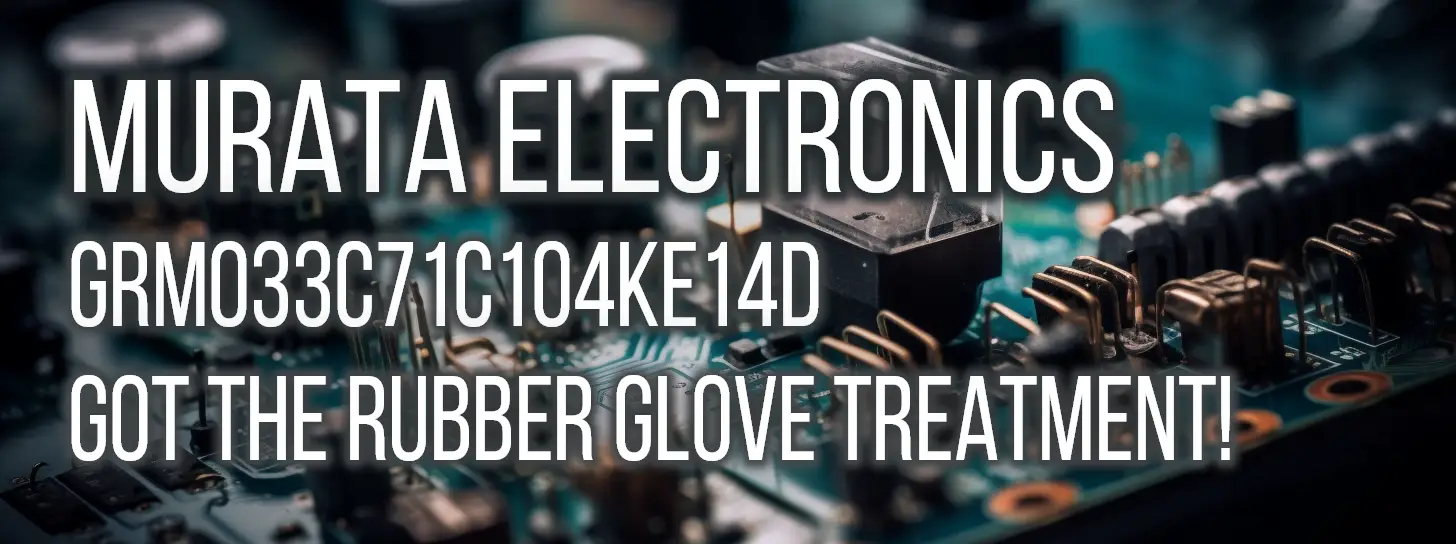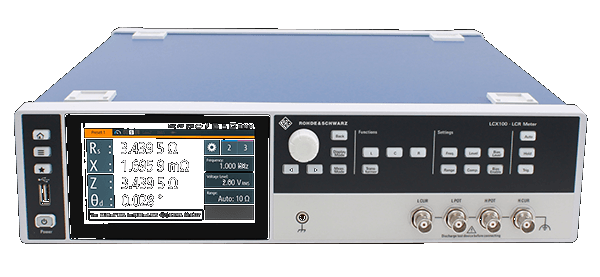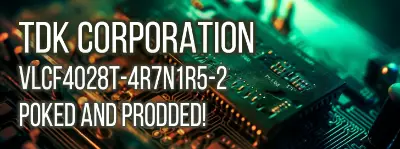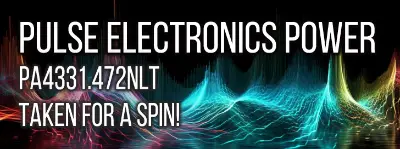Murata Electronics GRM033C71C104KE14D: An In-Depth Analysis of the 100nF Ceramic: X7S Capacitor
By Mark Harris Wednesday, 29 March 2023

Introduction
This technical review aims to provide a comprehensive analysis of the performance of Murata Electronics' GRM033C71C104KE14D Capacitor compared to a statistical benchmark formed from other components of the same value. The main focus is to offer a valuable, balanced, insightful, persuasive, and trustworthy assessment of this Capacitor for suitability in electronic circuits. To accomplish this, we will make comparisons between the Capacitor's data and the statistical benchmark data gathered for the scope of this review. The benchmark data provided will serve as a base to thoroughly scrutinize and juxtapose the Capacitor’s LCR measurements, capacitance and series resistance, dissipation factor and quality factor, and other relevant aspects for a comprehensive comparative analysis.
As an engineer assessing the suitability of this ceramic X7S Capacitor for your circuits, you'll want to know its pros and cons. Here's a brief list:
- Pros
- Wide range of test frequencies
- Good capacitance performance at lower test frequencies
- Satisfactory quality factors at some intermediate test frequencies
- Cons
- Decreased capacitance at higher test frequencies
- Inconsistent quality factors within the tested frequency range
- Missing data for some parameters at higher test frequencies at 10 Volts
With further assessment in the subsequent sections, this technical review will help engineers evaluating the GRM033C71C104KE14D Capacitor in deciding its suitability for their specific applications.
Impedance
In this section, we will analyze the impedance performance of the Murata Electronics GRM033C71C104KE14D capacitor. Through closely examining its LCR measurements at 1 Volt and 10 Volts, we will compare the capacitor's performance to the statistical benchmark comprised of other components with equivalent nominal capacitance values. Overall, the impedance values of the GRM033C71C104KE14D capacitor display satisfactory performance compared to the benchmark data across most test frequencies.
For instance, at 1 Volt and a test frequency of 50kHz, the GRM033C71C104KE14D capacitor exhibits an impedance of 30.67k Ohms. In comparison to the benchmark's average impedance of 31.67k Ohms, this capacitor performs reasonably well. Similar conclusions can be drawn for higher test frequencies, such as at 100kHz, with a 1 Volt test condition, where the capacitor's impedance of 19.87k Ohms compares favorably to the benchmark's average impedance of 18.07k Ohms.
However, it is worth noting that the component's impedance does deviate at lower test frequencies. Particularly, at 5kHz, the GRM033C71C104KE14D capacitor displays an impedance value of 302.5k Ohms, which falls below the benchmark's average impedance of 313.4k Ohms. A similar pattern emerges at 10kHz, where the capacitor's impedance of 151.5k Ohms is slightly lower than the benchmark's 157.2k Ohms average.
As impedance tends to be inversely proportional to frequency, capacitors exhibit a reduction in impedance as frequency increases. This characteristic can be valuable for applications, such as filtering circuits, where high impedance at low frequencies prevents unwanted signals from passing through and provides better performance at higher frequencies.
Overall, the Murata Electronics GRM033C71C104KE14D capacitor demonstrates satisfactory performance in impedance across a variety of test frequencies, notably in the mid to high frequency range. The lower test frequencies reveal mild deviations from the benchmark, indicating room for improvement in certain applications. For engineers considering this capacitor as a potential addition to their circuits, the GRM033C71C104KE14D capacitor can be a reliable and efficient inclusion, with minor impedance variations observed at specific low test frequencies.
Capacitance
At a 1-volt test condition, the GRM033C71C104KE14D's series capacitance varies depending on the frequency. For frequencies between 5Hz and 1MHz, the capacitance lies between 65.91nF and 105.7nF. Within the test frequency range of 5Hz to 10kHz, this capacitor consistently exhibits a series capacitance above the statistical benchmark average across all tested frequencies. For instance, the series capacitance measured at 5Hz (105.7nF) is significantly higher than the benchmark average (101.8nF), suggesting better performance in this range.
However, when the test frequency falls between 20kHz and 1MHz, the GRM033C71C104KE14D's capacitance drops below the benchmark average. This performance difference becomes more pronounced at higher frequencies. For example, at 300kHz, the capacitor's 71.23nF capacitance is 16% below the benchmark average of 84.79nF, indicating reduced performance in that range.
When tested at 10 volts, the GRM033C71C104KE14D exhibits a different behavior. The capacitor's capacitance exceeds the benchmark average at mid-range frequencies (e.g., 50kHz), where it measures 106.8nF, significantly surpassing the benchmark average of 91.32nF. However, the GRM033C71C104KE14D's capacitance falls lower than the benchmark average within the lower frequency range of 5Hz to 10kHz, demonstrating its limitations in this range. Overall, the capacitor's performance is frequency-dependent, highlighting the importance of understanding the required operating conditions for a particular application.
Series Resistance
In this section, we analyze the series resistance performance of the Murata Electronics GRM033C71C104KE14D Capacitor and compare it to a statistical benchmark established from other components of similar capacitance value. Series resistance, also known as equivalent series resistance (ESR), plays a significant role in determining the capacitor's behavior in AC circuits, affecting its impedance, power dissipation, and overall efficiency.
Upon examining the GRM033C71C104KE14D capacitor at 1 volt, it is observed that the capacitor has a higher series resistance across most test frequencies compared to the average series resistance (Ohms) of the statistical benchmarks (e.g., 83 Ohms at 1 kHz Test Frequency compared to Avg. 46.51 Ohms; 10.29 Ohms at 10 kHz Test Frequency compared to Avg. 5.163 Ohms). However, at the higher test frequencies above 450 kHz, the capacitor's series resistance tends to be closer to or slightly below the average series resistance from the benchmark data (e.g., 116.5 mOhms at 1 MHz Test Frequency compared to Avg. 70.07 mOhms).
When analyzed at 10 volts, the GRM033C71C104KE14D exhibits a similar pattern in its series resistance performance. It starts with higher series resistance values compared to the benchmark's average series resistance at lower test frequencies and converges when moving towards higher frequencies (e.g., 90.69 Ohms at 1 kHz Test Frequency; 14.72 Ohms at 10 kHz Test Frequency).
The Murata Electronics GRM033C71C104KE14D capacitor demonstrates higher series resistance compared to the statistical benchmark, especially in the lower test frequency range. However, it shows a convergence trend as the test frequencies increase, with its series resistance values getting closer to or slightly below the benchmark average at higher frequencies. Engineers evaluating this capacitor for use in their circuits should carefully consider the implications of its series resistance values and assess whether the component's performance aligns with their specific circuit requirements and performance expectations.
Dissipation Factor and Quality Factor
In this analysis, the Murata Electronics GRM033C71C104KE14D Capacitor demonstrates fairly consistent dissipation factor (Df) values at a 1 Volt operating bias across the range of test frequencies. The average Df value is calculated at 0.051, which provides insight into its capacitive energy storage efficiency. At the same time, the average quality factor (Q) at 1 Volt is found to be 19.25, displaying decent performance when compared to the benchmark. However, it should be noted that the Q factor deviates the most at higher test frequencies, such as 850 kHz, where it reaches a value of 20.98. This deviation must be considered and might affect the component's suitability in high-frequency applications.
When tested at a higher operating bias of 10 Volts, the GRM033C71C104KE14D exhibits an improvement in the dissipation factor. At 50 kHz, the Df value decreases to 0.030, which is significantly lower compared to the Df value at 1 Volt. This highlights the component's enhanced energy efficiency at higher voltages. Interestingly, the Df values become more stable over a wider range of test frequencies while operating at 10 Volts, which is an advantageous property in various circuit applications. The average Df value at 10 Volts is determined to be 0.069, while the average Q factor comes out to be 13.91, indicating better overall performance under higher voltage conditions.
Comparative Analysis
The component under review, the Murata GRM033C71C104KE14D, is a Ceramic: X7S capacitor with a nominal value of 100n, tolerance of ±10%, and voltage rating of 16 V. The capacitor is designed for surface mount applications, and its package type is 0201 (0603 Metric). In this analysis, we will be examining the performance of the component against the statistical benchmark data formed from other capacitors of the same value.
At a test frequency of 10 Hz, the GRM033C71C104KE14D capacitor offers a lower impedance of 210.3k Ohms, compared to the average impedance of 157.2k Ohms from the benchmark data. Furthermore, its series resistance is 8.089k ohms, while the benchmark's average series resistance is 4.329k ohms. These differences reflect the component's performance in terms of efficiency and power losses in low-frequency applications.
At higher test frequencies such as 50 kHz and 1 MHz, the GRM033C71C104KE14D exhibits relatively higher impedance and series resistance values, compared to the benchmark average. For instance, at 1 MHz, the GRM033C71C104KE14D has an impedance of 2.417k Ohms and a series resistance of 116.5m Ohms, which are higher than the benchmark averages of 1.958k Ohms and 70.07m Ohms, respectively. This greater impedance and series resistance may result in reduced filtering and decoupling effectiveness in high-frequency circuits.
In terms of dissipation factor, the GRM033C71C104KE14D capacitor's performance is slightly different from the benchmark data. For example, at a test frequency of 100 kHz, the component's dissipation factor is 0.072, whereas the benchmark average is 0.03. As the dissipation factor indicates the capacitor's energy waste, higher values may lead to increased power loss.
In conclusion, the GRM033C71C104KE14D capacitor by Murata Electronics showcases mixed results when compared to the statistical benchmark data. Its performance varies at different test frequencies, with values in impedance, series resistance, and dissipation factor deviating from the benchmark averages. When evaluating this capacitor for use in circuits, it is essential to consider these performance aspects and their impact on the overall application requirements.
Conclusion
In summary, the Murata Electronics GRM033C71C104KE14D is a solid X7S ceramic capacitor option with a nominal value of 100n, a ±10% tolerance, and a voltage rating of 16 volts. The component outperforms the statistical benchmark in some key areas, yet falls short in others when compared to other capacitors of the same value.
Regarding certain key performance parameters, the GRM033C71C104KE14D demonstrates a lower impedance across a range of test frequencies when compared to the maximum values of the statistical benchmarks. In addition, the quality factor of the component is marginally higher at lower frequencies in contrast to the benchmark, showcasing this capacitor's ability to minimize energy loss. Similarly, its dissipation factor falls within expectations, indicating that it is generally comparable to its counterparts of equal voltage rating.
It is crucial to highlight that the GRM033C71C104KE14D's series resistance and capacitance levels are consistent with the benchmark values while maintaining a compact 0201 (0603 Metric) package design, a competitive advantage for engineers working with space-constrained applications.
However, the component data at 10 Volts exhibits a few discrepancies when compared to the benchmark, especially at higher test frequencies, missing some vital information. Thus, engineers should thoroughly investigate the missing LCR measurements to ensure appropriate use cases and requirements.
In conclusion, the GRM033C71C104KE14D stands as a dependable choice among ceramic X7S capacitors for engineers who prioritize lower impedance, a compact package, and a higher quality factor in their applications. On the other hand, it is essential to verify further the capacitor's performance under 10 Volts and higher test frequencies before committing to any design decision.
Instruments Used
Rohde & Schwarz LCX200



